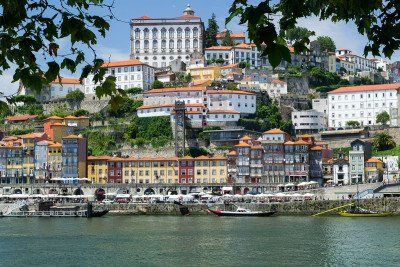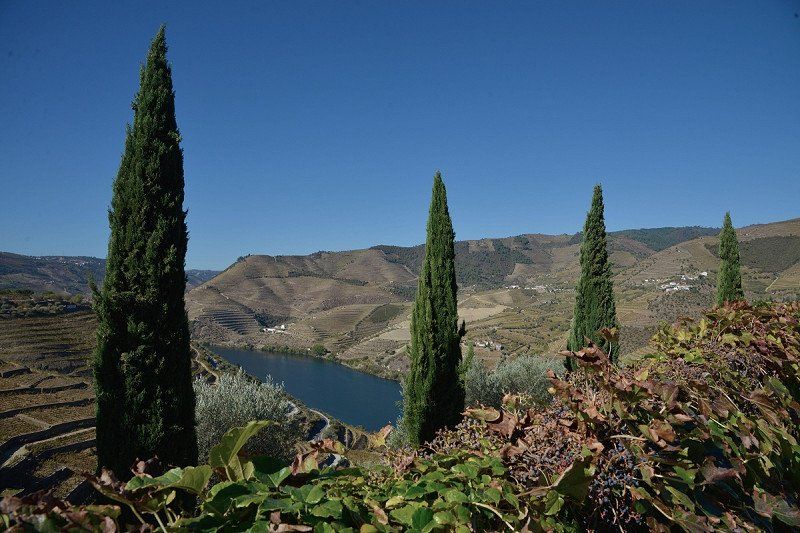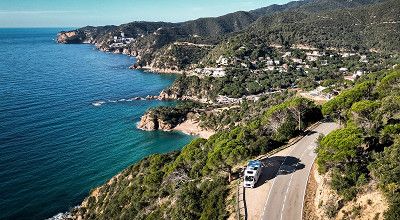Join us on a motorhome tour around the north of Portugal: we get to travel through the fertile wine-growing region "Vale do Douro" to Porto, the pulsating capital of port wine, in a campervan. We then continue south and discover the lovely harbour town of Aveiro and one of the oldest university cities in Europe: Coimbra. We will also follow in the footsteps of J.K. Rowling and try unusual specialities such as “Francesinha” and “Bacalao”.

Best time to travel and infrastructure for campers in Portugal
Portugal is one of the most popular destinations for motorhome enthusiasts and there's a reason why: while it is often cloudy and cool in the northern regions of Europe in spring and autumn, the fertile land of seafarers and explorers is bursting with sun, blooming landscapes and southern flair. So we would always recommend September to November and March to June as the best time to travel to this beautiful spot. In winter you will have to expect frequent rainfall and rough Atlantic winds, whereas many places attract a large number of tourists during the hot summer months. In addition to the pleasant climate, campers will also appreciate the good infrastructure. The country has a well-developed road network and many campsites where you can spend the night comparatively cheaply. Wild camping is not allowed in Portugal.

Stopover #1: Vale do Douro – green vineyards, traditional quintas and fairytale castles
Once in Portugal, we follow the course of the Rio Douro. The almost 900 km long river has its source in the Spanish province of Soria, flows across the north of Portugal and finally opens into the Atlantic at Porto. The picturesque landscape has been shaped by viticulture for thousands of years. Nestled among rolling hills, traditional quintas (wineries) hold guided tours and tastings. Historical castles are scattered throughout the area and no one would be surprised if Sleeping Beauty were to suddenly let her hair down from one of the belfry windows with this fairytale backdrop. Incidentally, the Vale do Douro is also home to the oldest wine region in the world, "Alto Douro", which is known for its excellent port wine. The sweet grapes have been cultivated here for more than 2,000 years.
Tip: one of the most popular routes for the Douro Valley is the N222. This country road (speed limit 90 km/h) runs parallel to the river and promises breathtaking views. The route from Pinhão to Peso da Régua was even named the best road in the world by the rental company Avis in 2015 thanks to the unique combination of scenic highlights and good road conditions. Some places worth visiting are Pinhão with its numerous wine terraces and wineries, Peso de Régua with its exciting Douro Museum, the episcopal city of Lamego with its pilgrimage church, and the numerous traditional small wine villages that are lined up like pearls on a chain along the river bank such as Barcos, Favaios, Ucanha, Salzedas, Provesende and Trevões. There are several campsites in the Douro Valley, a selection can be found at the end of this post.

Stopover #2: Porto – the home of port wine, vibrant bars and exceptional cuisine
Following the Rio Douro, the road takes us straight to Porto. Welcome to the beautiful city of port wine! The city that inspired J.K. Rowling to create many of the scenes in her Harry Potter novels. The best way to discover Porto is on foot as many of the alleys are so narrow and winding that not even a car, let alone a motorhome, would be able to fit through them. Bars and restaurants in the small colourful houses adorned with "azulejos" (typical Portuguese tiles) are perfect for soaking up the atmosphere. And as soon as you think you've discovered the most beautiful square in the city, you'll be forced to change your mind when you turn into another street.
Be sure to visit one of the wineries – most of them are located around the estuary. You will not only learn more about the history of port wine, but also get to taste a variety of good wines. Take advantage of the comparatively low prices in the restaurants and pubs and try some local dishes such as Francesinha or the Portuguese Super Bock beer. In this case, it is best to simply park your motorhome at the car park in Porto.

Food you have to try: culinary highlights in Porto
Francesinha is an experience in itself: this mighty sandwich is filled with various meat and sausage specialities, swims in a hearty sauce, is covered with melted cheese and served with a fried egg on top and French fries on the side. Some people can't get enough of this nutritious sandwich, while others feel full just by looking at it. The same goes for bacalao – dried and salted cod – which is the Portuguese national dish. When you enter a supermarket, the smell of this dried fish, which admittedly takes some getting used to, will hit you immediately. But why does a nation on the Atlantic coast that has a large selection of freshly caught fish on their doorstep all year round eat dried fish at all? This goes back to Portugal's history: along with sauerkraut, bacalao was once essential for seafarers to prevent scurvy. This is because the fish loses hardly any of its nutrients when it is dried and over the centuries it has fed dozens of crews on their sea voyages, which were full of deprivation. Today, countless Portuguese recipes contain stockfish, which now mainly comes from Nordic waters, as the main ingredient.

Porto on the trail of Harry Potter
We now get to the mystical side of Porto, which not least cast a spell over J.K. Rowling. The author, who went on to become an international bestselling writer, spent around two years in Porto in the early 1990s, working as an English teacher as well as on her very first Harry Potter novel. Rowling spent a lot of time at the Lello & Irmão book store, which insiders claim inspired the library at Hogwarts and the changing staircases in the castle. In fact, there are many things in Porto that will remind you of the Harry Potter world, such as the old university where students come and go in black, floor-length uniforms.
Another source of inspiration for Rowling's Harry Potter series is the Jardins do Palácio de Cristal city park where the author liked to stroll. The romantic garden is said to have been the template for the forbidden forest and the maze of the Triwizard Tournament in the fourth Harry Potter novel. If you lose yourself in the winding paths and look at the rare plants and ancient sculptures, then this theory is not far off. Either way, these gardens in Porto are a worthwhile destination that once again shows the city from its magical side.

Stopover #3: Aveiro – the Venice of Portugal
Enchanting Art Nouveau architecture, picturesque fishing districts, brightly painted boats and romantic canals – thanks to these characteristics, Aveiro is also referred to as the Venice of Portugal. But the city is much more than that. Located on the banks of the salt water lagoon of the Aveiro River, it offers Portuguese tradition, excellent cuisine – with freshly caught fish and seafood right at the top of the list – and a relaxed holiday atmosphere. The most authentic way to experience the city is to take a tour on one of the colourful Moliceiro boats. These charming boats were once built to harvest seaweed and algae for agriculture and livestock and transport them to shore. Today, they are adorned with historical, religious and sometimes surprisingly provocative, tongue-in-cheek paintings and carry Aveiro's tourists across the canals. You can find out more about these extraordinary boats by visiting the "Museu Maritimo" maritime museum, which also shines a light on the history of the precious sea salt that once brought great wealth to this city.

In addition to the typical Portuguese food and fresh fish dishes, you should try the local speciality "Ovos moles de Aveiro". The origins of this dessert containing egg yolk and sugar goes back to nuns: they would use egg white to strengthen their habits. This in turn led to a surplus of egg yolk, which went off quickly. The nuns mixed it with sugar so it would keep longer – and voilà, this sweet dessert was born. Other tips for Aveiro are the Mercado do Peixe fish market, the Jardim do Rossio park and a tour of the many small shops and boutiques.
Stopover #4: Coimbra – the city of many stairs and the oldest university in Portugal
Our journey continues inland, to Coimbra. What hardly anyone knows: this city was once the capital of Portugal. It is home to the oldest university in the country and many young students continue to influence the cityscape to this day. Coimbra also has a certain mystical flair, which comes from the many ancient churches, cathedrals and houses, mysterious libraries and again the long black school uniforms. You can experience Coimbra on foot. The distances in the centre of the almost 106,000-strong city are short and you will be surprised on your wanderings by the beautiful Mondego River bank, the colourful, dwarf-like old buildings and the hilly geography of this small town.

Coimbra is also a city of stairs – the most famous is the Quebra Costas, which translates as backbreaker. These stairs with countless steps lead down to the lively old town district by the river. Locals and visitors stop by the many small and inexpensive restaurants and bars here, where live fado songs are often played in the evenings. Fado is Portuguese folk music that is full of melancholy, beautiful and very emotional. It is not uncommon for even steadfast Portuguese locals to have tears rolling down their cheeks when they hear this music as the songs are about past loves, former times, social grievances and the longing for better times.

Sightseeing in Coimbra
You can't go to Coimbra without visiting the university. It was founded in 1290 and its building reflects architectural styles from different eras, especially Baroque. Be sure to take a look at the three-storey Joanina Library: its entrance on the university's central square is inconspicuous, so you will be all the more amazed when you enter the historic halls. Among the roughly 200,000 books, some of which are centuries old, there is also a magnificent life-size portrait of King John V who founded the library in 1717. Another spectacular feature: the three rooms each have a different colour – gold, red and green.
If you want to immerse yourself in the history of Coimbra, pay a visit to the national museum, Museu Nacional de Machado de Castro. It houses the largest number of ancient sculptures in Portugal, numerous archaeological finds from the Coimbra region and a proud collection of medieval paintings, rugs and sacred works of art. Speaking of history: last but not least, the Igreja de Santa Cruz monastery is another Coimbra landmark. It was consecrated in 1228 and served as a burial ground for Portugal's kings, making it one of the most important places of worship in the country. You will also be amazed by the various architectural styles from different eras that are united under its roof.
A detour to Portugal's wild side
Interested in seeing an impressive natural spectacle? Then take a trip to Nazaré. This small coastal town is only about an hour's drive south of Coimbra and has some of the biggest waves in the world. Accordingly, many surfing world records have been set here. And if you are in the mood for some unspoilt nature on your way back home, then make a stop at the Serra da Estrella Natural Park, a popular destination for hikers and nature lovers.




























